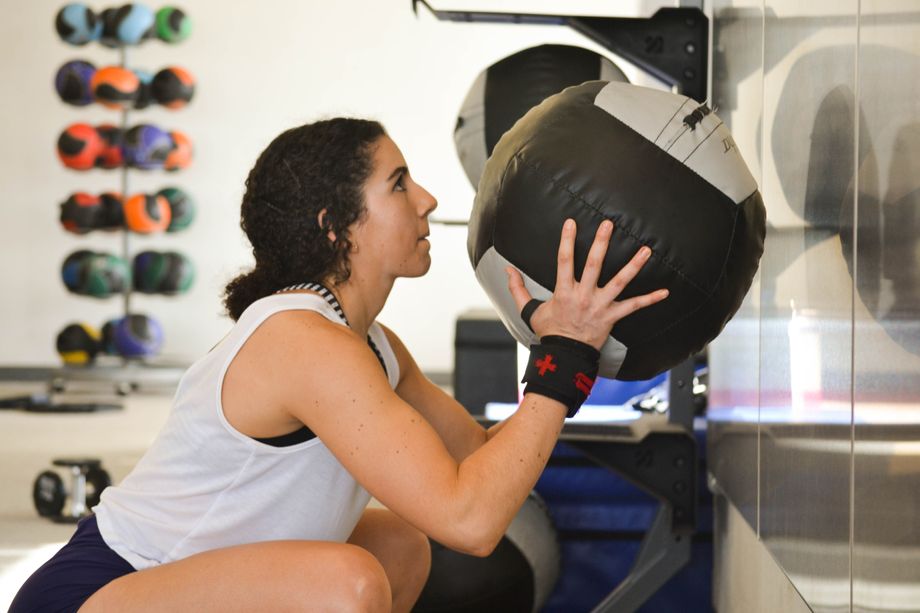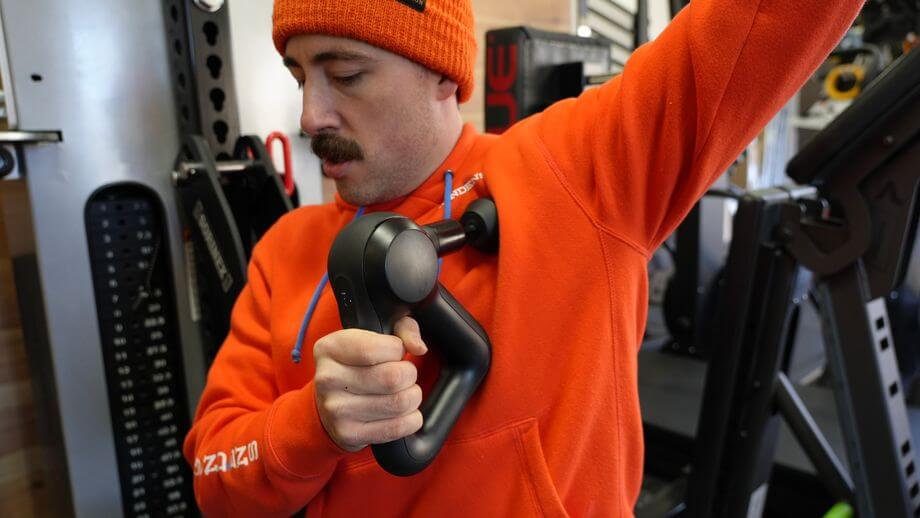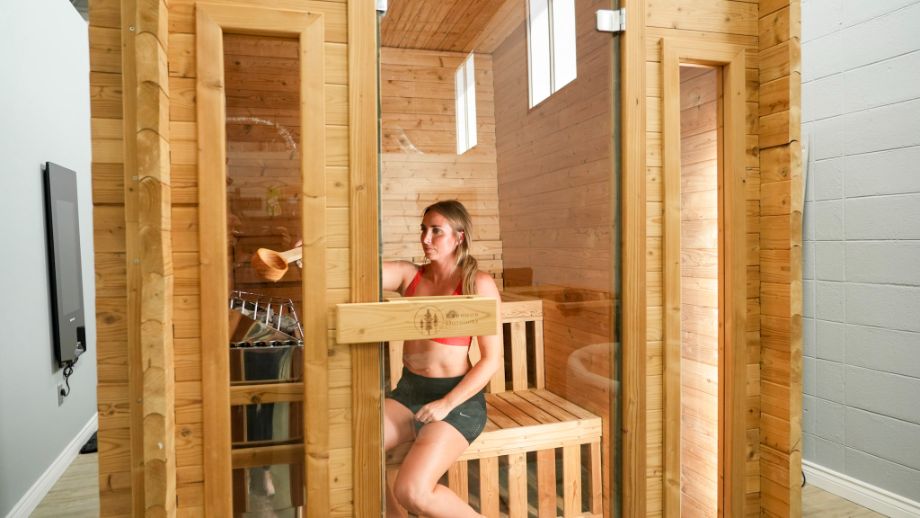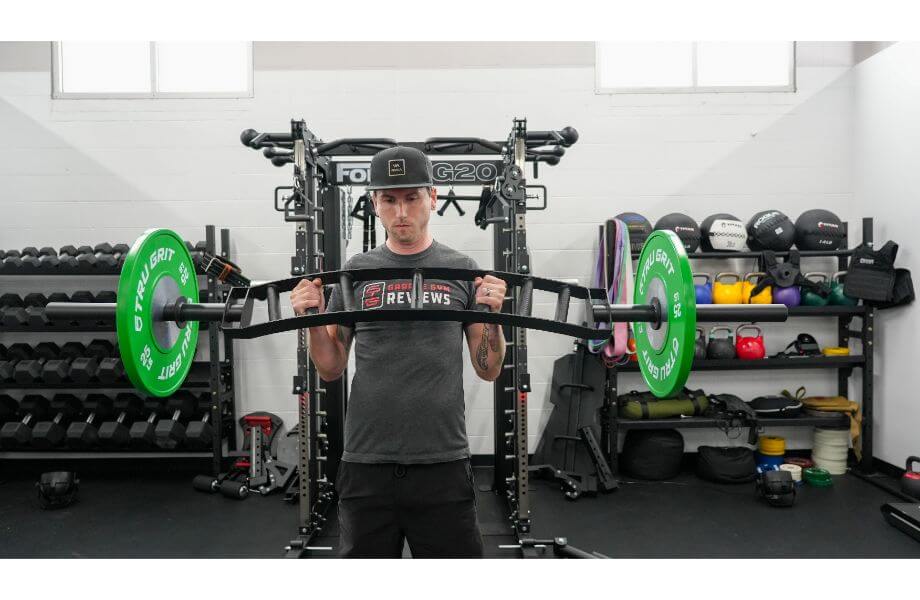Wall balls can seem wild to those who don’t do CrossFit. You line up facing a wall, hurl a heavy medicine ball into the air, watch it bounce off the wall, and come careening down to Earth only to catch it in a squat and thrust it upward again—for reps!
It’s a strange movement to say the least, but there’s a reason they’re heavily programmed in CrossFit boxes worldwide: they’re wildly effective. Launching that medicine ball sky high takes strength, coordination, and cardio conditioning, so wall balls are naturally an excellent exercise if you’re looking to up your game.
RELATED: Medicine Ball Workouts
Kate Meier, NASM-CPT, USAW-L1, CF-L1, and GGR director of content, shares everything you need to know about wall balls, including how to do them, how to program them into your workout, alternatives, benefits, and more!
Are you ready to go balls to the wall? Check out our wall ball workout guide below!
How To Do the Wall Ball
“The wall ball shot combines a med ball front squat with an explosive push press,” says Kate Meier, NASM-CPT, USAW-L1, CF-L1, “but it’s not only about strength and power; it’s also about coordination and timing. You want to catch the med ball as you’re squatting so you can effectively use your squat to slow the ball’s descent. Then, explode from the bottom of your squat and thrust the ball into the air in one fluid motion.”
How to do it:
- Stand with your feet shoulder-width apart, a medicine ball held at chest height with both hands, and a sturdy wall roughly arm’s length from your position.
- Push your hips back and bend your knees to drop into a squat position.
- Drive through your heels and explosively extend your knees, hips, and ankles to stand up and simultaneously propel the ball into the air. You’ll want to throw the ball so it mostly travels vertically with a little forward momentum so that the ball bounces off the wall approximately 9 to 10 feet up.
- Catch the ball on its descent and immediately cycle into the next rep.
- Repeat for reps.
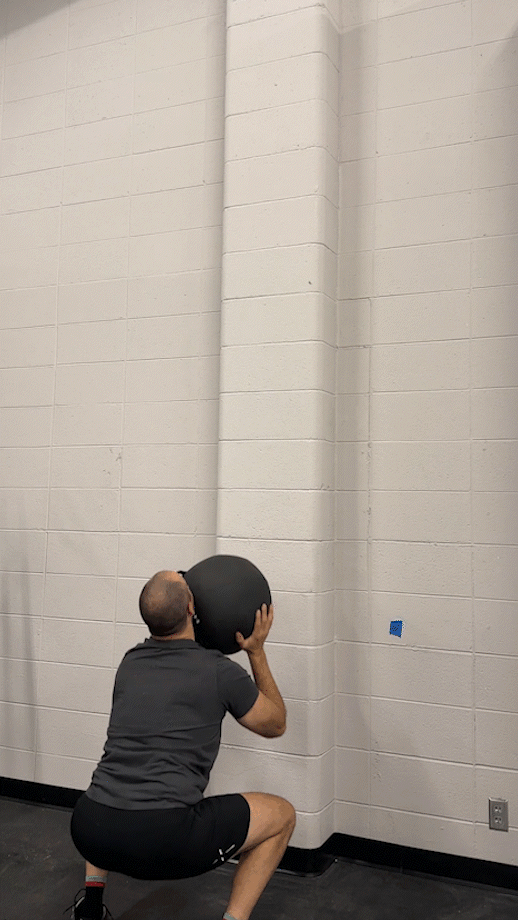
Modifications
- Dial it back: The CrossFit standard involves using a 20-lb medicine ball for men and throwing to a height of 10 feet, while women use a 14-lb medicine ball and throw to a height of nine feet. To modify, use a lighter medicine ball, throw to a lower height, or just substitute wall balls for medicine ball slams, front squats, push presses, or thrusters.
- Make it harder: The most common ways of upping the ante involve using a heavier ball or increasing the number of reps per set. Breaking your workout into rounds and racing against time often helps elevate the challenge, too, which is why CrossFit WODs almost always involve a running timer.
Sample Wall Ball Workouts
Wall balls work in most WODs, whether you’re using them as a warm-up to get that heart rate going or racking up the reps for a massive endurance workout. We’ve put together a few sample wall ball workouts below, each designed with a specific fitness goal in mind.

Check ‘em out; we’re sure you’ll have a ball with them!
Wall Ball Workouts for Endurance
“Muscular endurance is about keeping consistent over an extended period of time,” says Kate. “These wall ball workouts for endurance are all about getting into a rhythm and holding a steady pace until the workout is complete.”
RELATED: Stamina Vs Endurance
So, here are two ways to tackle this goal:
Endurance Workout 1
5-Minute Wall Ball AMRAP:
In 5 minutes, perform as many wall ball reps as possible. Aim to minimize the amount of rest taken and pick a pace that you can maintain for five minutes yet find moderately challenging. You should still be able to speak during this workout.
Endurance Workout 2
5 Rounds for Time:
- 50 wall balls
- Rest 60 seconds
“Use your first round to set a benchmark,” advises Kate. “You don’t want to go as hard as you possibly can—roughly 65% to 75% of your max effort should be sufficient—then, when you’re done with all 50 reps, stop the timer and record your time. Rest, then for the remaining rounds, your goal is to finish within a few seconds of your original time. Consistency is key.”
Wall Ball Workout for Stamina
“Stamina, on the other hand, is about performing at a high-intensity for a significantly shorter period of time,” says Kate. “This wall ball workout for stamina has you going all out to get the job done as fast as possible!”
Stamina Wall Ball Workout
10 Minute EMOM:
- 15 wall balls
- Rest
This one is sneaky and spicy. If you’re speeding through your reps, you’ll get some extra rest time, but every minute on the minute, it’s time for 15 more reps. The goal is to get your reps done ASAP so you have time to catch your breath; that way, you can really give it 100% every round.
“If you find yourself not finishing your 15 reps at the start of the next minute, switch to a lighter medicine ball or reduce the number of rounds,” says Kate. “You shouldn’t be doing wall balls without any rest for this workout. The point is to rest up so you can go hard each round.”
Wall Ball Alternatives
Beginners may find wall balls daunting, but they’re doable with a little guidance and practice. The wall ball alternatives below may also help you develop the strength, power, and coordination needed to master the wall ball.
Jump Squat
Why do it: Your feet stay planted during the wall ball shot, but the jump squat involves a similar movement pattern nonetheless. Both exercises involve a squat and triple extension of the hips, knees, and ankles, so you’ll be building the same muscle groups as the wall ball by doing jump squats regularly.
How to do it:
- Stand with your feet hip-width apart.
- Push your hips back and bend your knees to drop into a squat.
- Explosively drive through your heels and extend your hips, knees, and ankles to return to a standing position and launch into a jump.
- Land carefully, then immediately cycle into the next rep.
- Repeat for reps.
RELATED: 21 Best Squat Variations
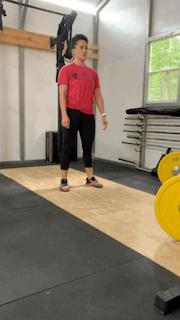
Dumbbell Thruster
Why do it: Dumbbell thrusters help build your upper body, lower body, and explosive power in one fell swoop. Like wall balls, they require a triple extension of your hips, knees, and ankles to perform efficient reps, making them a great alternative.
How to do it:
- Stand with your feet shoulder-width apart and a pair of the best dumbbells held with a neutral grip (palms facing each other) at shoulder height.
- Push your hips back and bend your knees to squat.
- Explode out of the bottom of the squat by driving through your heels and extending your hips, knees, and ankles.
- Use the momentum from your triple extension to propel the dumbbells into the overhead lockout position.
- Control the dumbbells’ descent back to the starting position.
- Immediately cycle into the next squat rep.
- Repeat for reps.
RELATED: Thrusters Workout
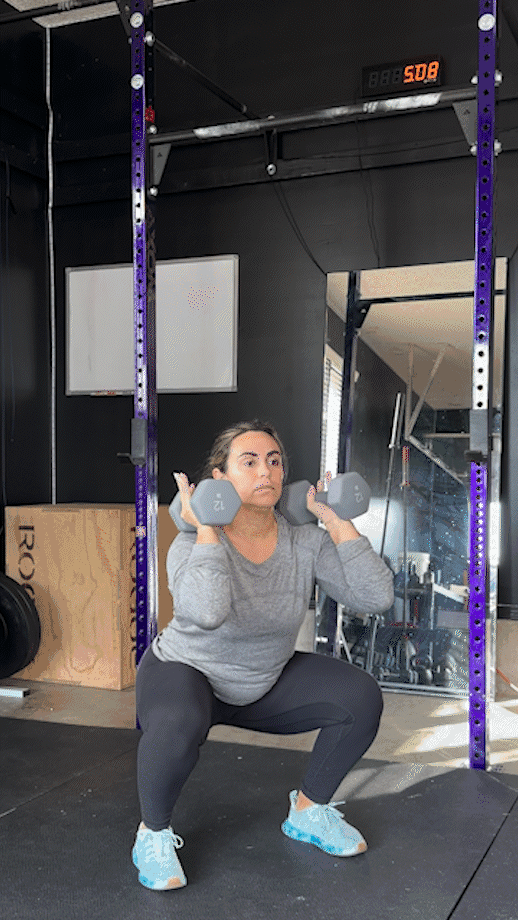
Medicine Ball Slam
Why do it: Slamming a medicine ball into the floor isn’t just a great way of building explosive power and core strength; it’s also great for letting off a little steam! Take out your frustrations while enhancing your overall athletic abilities by performing the medicine ball slam!
How to do it:
- Stand with your feet shoulder-width apart and a medicine ball or one of the best slam balls held with both hands at chest height.
- Raise the ball over your head, maintaining good upper body posture.
- Slam the ball to the floor using your arms, shoulders, and hips.
- Pick up the ball, reset, and repeat for reps.
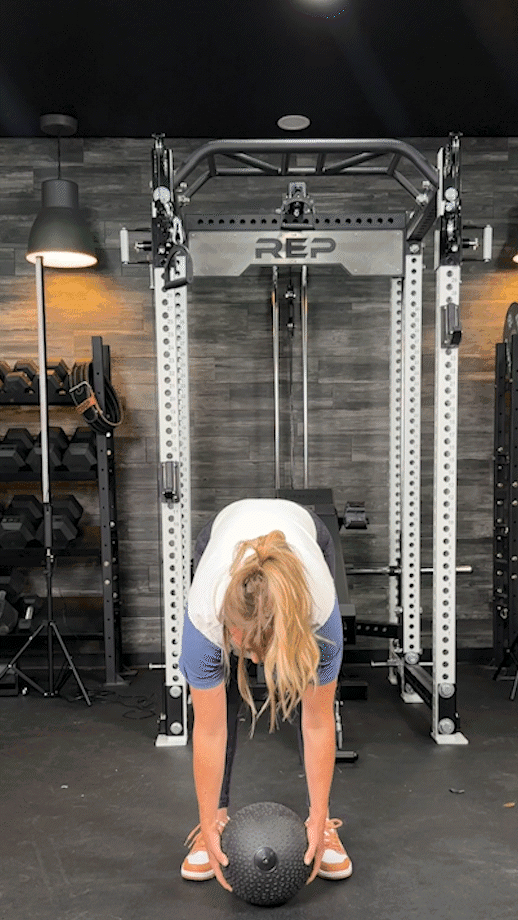
Benefits of the Wall Ball Exercise
There are many reasons why the wall ball is so widely used in CrossFit programming. Here’s a hint: it’s not just to strike fear into the hearts of CrossFitters worldwide whenever they see the Karen WOD—150 wall ball shots—on the whiteboard.
Here are our favorite benefits of doing wall balls regularly.
Can Help Build Endurance
It takes some serious strength and endurance to cycle wall ball reps because high-rep sets of wall ball shots are essentially massive sets of goblet squats with the bonus of having to throw the weight through the air each rep and catch it on the comedown.
“Maintaining a strong posture while doing wall ball shots requires excellent muscular endurance, core strength, and stability,” says Kate Meier, NASM-CPT, USAW-L1, CF-L1. “So, working wall balls into your regular strength training should yield some increases in your overall endurance.”
May Help Improve Cardiovascular Health
Even smaller sets of wall balls are sure to spike your heart rate and get the blood flowing, which means you may improve your cardiovascular health while you’re at it. Wall balls are inherently a high-intensity exercise, and because you tend to see them in CrossFit WODs, most workouts with wall balls incorporate elements of HIIT (high-intensity interval training).

According to the International Journal of Environmental Research and Public Health1, HIIT may decrease an individual’s risk of cardiovascular disease, stroke incidence, and other adverse medical conditions.
May Help Enhance Athletic Performance
A well-executed wall ball shot involves generating power at the bottom of the movement and then executing a triple extension of the hips, knees, and ankles. Regularly performing this movement, therefore, not only increases your ability to produce explosive power but may also translate to enhanced performance on the playing field.
A 2015 trial published in the Journal of Strength and Conditioning Research2 concluded, “Medicine ball training exercises [may] be a useful and inexpensive strength training strategy in enhancing functional performance by closely mimicking sport-specific movement activities.”
In addition, a 2023 study3 in the Journal of Strength and Conditioning Research found that collegiate baseball players showed “significant [increases in] key parameters of bat swing performance” after incorporating wall ball shots in their warm-ups.
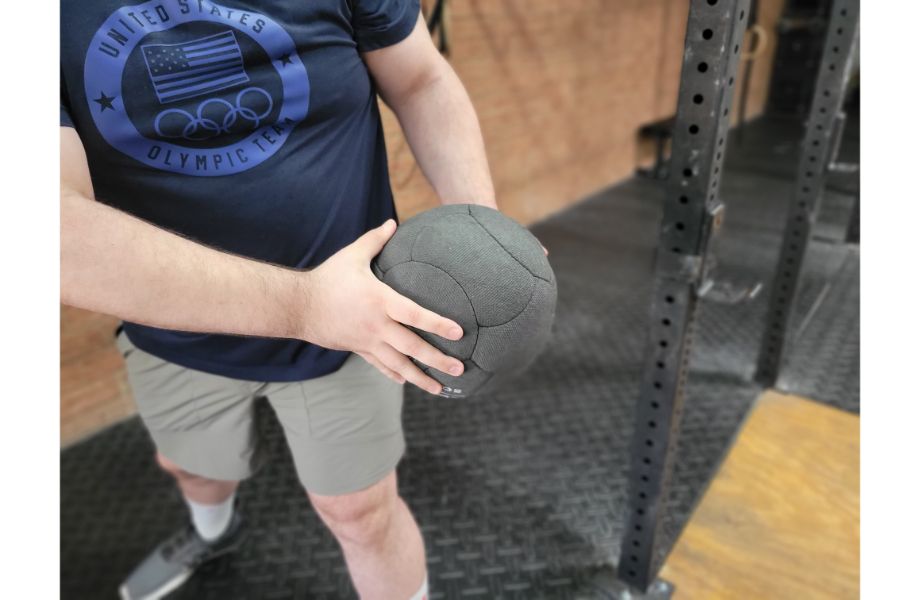
So, wall ball shots can potentially improve your explosive power, functional fitness, athletic performance, and more if performed as part of your regular training.
RELATED: Explosive Workouts
Muscles Worked by the Wall Ball
The wall ball is a full-body exercise, so you’ll need muscle groups throughout your entire body firing on all cylinders to perform this movement. The main players here include:
- Quads: Your quadriceps, positioned prominently on top of your thigh, work to control knee flexion, meaning you’ll be relying on them heavily to perform the squat portion of the wall ball movement.
- Glutes: Your gluteal muscles are largely responsible for extending your hips, so you’ll need to flex your glutes to get a good hip extension and generate power as you stand back up from your squat.
- Upper body: As you explode out of your squat, you’ll need to use that force to propel the ball into the air using upper-body muscles like your shoulders, chest, and triceps. You don’t want to overuse your upper body here, as the power comes from a strong triple extension, but you’ll need it to throw the ball and catch it on the way back down.
- Core: To maintain good posture during the squat and the catch, you need to keep your core muscles engaged.
Wall Ball Workout: Final Thoughts
Don’t be a wallflower! Wall ball workouts are highly effective when programmed and performed properly. Wall ball shots:
- Combine the benefits of a med ball squat and a push press
- Help improve cardio
- Help increase endurance
- Provide a full-body workout
- May enhance athletic performance
- Help develop better coordination
There’s no reason barbells, dumbbells, and kettlebells should have all the fun in your home gym. Pick up a medicine ball and work our wall ball workouts into your training today!
Wall Ball Workout: FAQs
How heavy should my wall ball be?
For beginners, we recommend in the range of six to 10 pounds to start and progress gradually as you gain proficiency. If you’re working your way up to tackling “Rx” CrossFit WODs, keep in mind that men are prescribed 20-pound med balls while women are prescribed 14 pounds.
What exercises help wall balls?
“Any exercise that involves a triple extension and generating explosive power should help translate to better wall ball mechanics and performance,” says Kate Meier, NASM-CPT, USAW-L1, CF-L1, and GGR director of content. “We mentioned jump squats, dumbbell thrusters, and med ball slams above, but Olympic lifts like cleans, jerks, snatches, and more should help as well.”
RELATED: Best Olympic Barbells
Do wall balls work abs?
In short, yes, wall balls definitely work your abs!
“High-intensity squats rather than isometric low-intensity core exercises…resulted in greater erector spinae activation [and] similar rectus abdominis and oblique external activation,” according to the Journal of Human Kinetics4.
The wall ball shot basically combines a squat with a push press, so, by this logic, you can conclude that you will receive similar core activation when performing high-intensity squats or wall ball shots.
References
- Mamen A, Øvstebø R, Sirnes PA, Nielsen P, Skogstad M. High-Intensity Training Reduces CVD Risk Factors among Rotating Shift Workers: An Eight-Week Intervention in Industry. Int J Environ Res Public Health. 2020;17(11):3943. Published 2020 Jun 2. doi:10.3390/ijerph17113943
- Raeder C, Fernandez-Fernandez J, Ferrauti A. Effects of Six Weeks of Medicine Ball Training on Throwing Velocity, Throwing Precision, and Isokinetic Strength of Shoulder Rotators in Female Handball Players. J Strength Cond Res. 2015;29(7):1904-1914. doi:10.1519/JSC.0000000000000847
- Buso D, Willardson JM, Shafer AB. Effects of Medicine Wall Ball Throws With Whole-Body Vibration on Bat Swing Performance in Collegiate Baseball Players. J Strength Cond Res. 2023;37(10):2071-2075. doi:10.1519/JSC.0000000000004584
- van den Tillaar R, Saeterbakken AH. Comparison of Core Muscle Activation between a Prone Bridge and 6-RM Back Squats. J Hum Kinet. 2018;62:43-53. Published 2018 Jun 13. doi:10.1515/hukin-2017-0176


